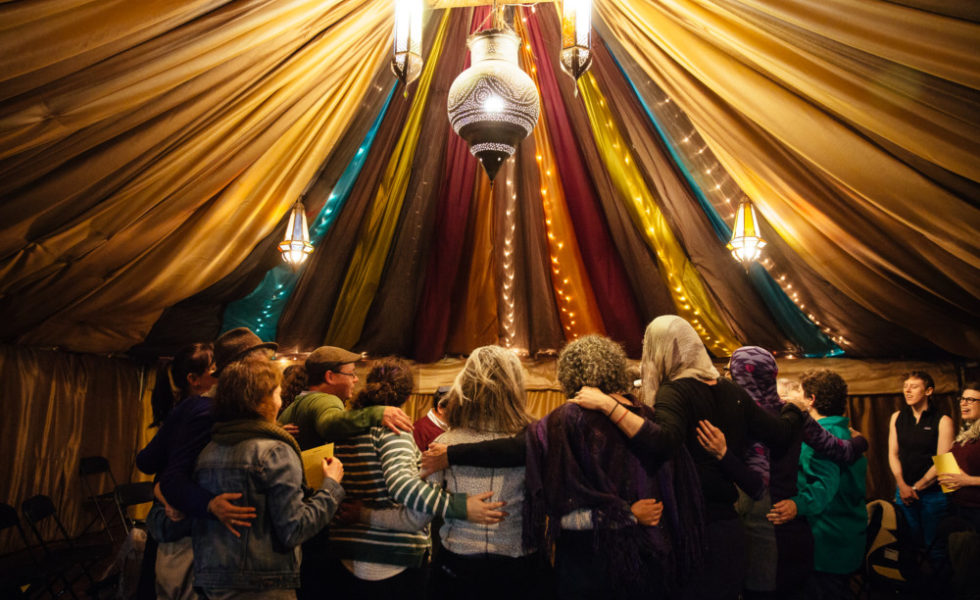Unlocking the Language of the Universe

by R’ Hayley Goldstein, SVARA Fellow
It was a freezing, albeit sunny, Ithaca day. I had invited members of my community to brave the January cold to learn about wild foraging in honor of Tu b’Shvat. I couldn’t feel my toes so I ripped open a couple of hand-warming packs, shook them vigorously to get the warming chemicals moving and shoved a pack inside each of my boots. “Who here speaks a language other than English?” our foraging guide asked us. Many hands went up in the air. “What would you see looking at a page of Spanish if you didn’t speak or read Spanish? Not much, right? It’s like that with the forest.” He had his hand on a Sycamore tree. The tree’s colorful and beautifully textured bark became more prominent as he spoke. “When you speak the language of the forest, you are awake to a whole world that you weren’t before. Suddenly you see the beaver’s teeth marks in the tree bark, the type of trees that might have reishi mushrooms on it, the number of pine needles in each bundle which tells you what type of pine it is.”
During our guide’s lesson on learning the language of the forest, I was reminded of my first time looking at a page of Talmud. Even though I had some familiarity with the letters, as I gazed upon the page, I suddenly felt like I was swimming in a sea of them with no vowels or punctuation for me to use as flotation devices. It took a lot of time and gracious guides at SVARA and beyond to give me the tools to navigate it, until eventually I was, as our foraging guide said, awake to a whole world that I wasn’t before.
The mystics of our tradition regard the aleph-bet as a key that unlocks not only our sacred texts, but the primordial language of the universe. Sefer Yetzirah, the earliest known work on Kabbalah, describes the aleph-bet as being central to the creation of the world. “By means of the twenty two letters, by giving them a form and shape, by mixing them and combining them in different ways, G!d made the soul of all that which has been created and all of that which will be.” According to our mystic ancestors, these letters are the literal building blocks of the world. When we unlock them, we become fluent in the primordial language of the universe.
In this Spring Zman, I am beyond excited to connect back to the basics by fairying for Aleph-Bet Basics, a 5-week class to gather the building blocks of our tradition; the aleph-bet. During our weeks together, we will learn the Hebrew letters and their sounds, giving folks the tools they need to decode and unlock the infinite beauty and wisdom of our tradition, and perhaps, the universe.
At the end of our tour, while sipping pine needle tea, chaga mushroom tea, and nibbling on foraged nuts from the fall, we learned about sap. Our guide described tapping a maple tree in the woods years ago as a novice forager. After tapping one spot of the tree, he decided to move it to try to get a stronger flow. The next day, the original spot had sap bleeding out like an open wound, covering the trunk of the tree. Sap is the blood of the tree, he explained, carrying energy and nutrients out to the branches and leaves. It moves by way of the phloem, which is the vascular tissue of the tree. Though the tree seems unmoving, strong, and sturdy, there is life moving through it, it is constantly changing.
Perhaps our Torah is called an Etz Chayim, a Tree of Life, for this very reason. Though it seems unmoving, strong, and sturdy, or even stagnant to an outside eye, there is life coursing through it. That life force are the learners who are dedicated to keeping it alive and continuing the flow of movement and change. That life force, that blood, is us. Through the simple power of the aleph-bet, we have the key to keeping the sap flowing in our Etz Chayim, for us and future generations.
 SVARA: A Traditionally Radical Yeshiva
SVARA: A Traditionally Radical Yeshiva